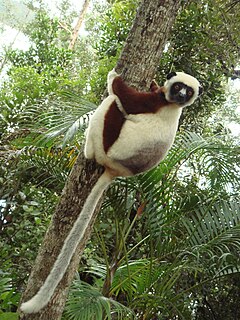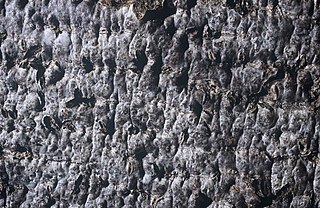
A sifaka is a lemur of the genus Propithecus from the family Indriidae within the order Primates. The name of their family is an onomatopoeia of their characteristic "shi-fak" alarm call. Like all lemurs, they are found only on the island of Madagascar. All species of sifakas are threatened, ranging from endangered to critically endangered.
Takhtajania is a genus of flowering plants of the family Winteraceae, which contains a single species, Takhtajania perrieri. It is endemic to Madagascar.

Joseph Marie Henry Alfred Perrier de la Bâthie was a French botanist who specialized in the plants of Madagascar.

Adansonia perrieri, or Perrier's baobab, is a critically endangered species of deciduous tree, in the genus Adansonia. This species is endemic to northern Madagascar. It has been documented in only 10 locations, including Ankarana, Ampasindava, Loky Manambato and Montagne d'Ambre protected areas. Most populations, however, are outside of protected areas. Each location has few individuals. With an estimated population of fewer than 250 mature individuals and ongoing habitat decline due to fire and cutting for charcoal and timber or clearing for mining, this species has been assessed by IUCN as Critically Endangered. There are three species of baobab found in northern Madagascar, all sharing the common name "bozy".
Erythrina perrieri is a species of legume in the family Fabaceae. It is found only in Madagascar.
Phylloxylon arenicola is a species of legume (bean) in the family Fabaceae. It is found only in Madagascar.
Phylloxylon is a genus of flowering plants in the Indigofereae tribe of the family Fabaceae. There are seven species, all endemic to Madagascar.
Phylloxylon decipiens is a species of legume in the family Fabaceae. It is found only in Madagascar.
Phylloxylon phillipsonii is a species of legume in the family Fabaceae. It is found only in Madagascar.
Phylloxylon spinosa is a species of legume in the family Fabaceae. It is found only in the northern tip of Madagascar. The tree is commonly harvested from the wild for local use of its hard and very durable wood. Selective and intensive harvesting for its favored construction properties means it is expected to decline rapidly. The species is classified as 'Endangered' in the IUCN Red List of Threatened Species.
Phylloxylon xiphoclada is a species of legume in the family Fabaceae. It is found only in Madagascar.
Podocarpus perrieri is a species of conifer in the family Podocarpaceae. It is found only in Madagascar.
Dypsis perrieri is a species of flowering plant in the family Arecaceae. It is found only in Madagascar. It is threatened by habitat loss.
Haplochromis perrieri is a species of cichlid endemic to Lake Victoria though it may now be extinct in the wild. These fish are part of the Lake Victoria Species Survival Program, and captive populations exist within the public aquarium community. This species can reach a length of 6 centimetres (2.4 in) SL. This species' specific name honours the French zoologist Edmond Perrier (1844-1921) who was the director of Muséum National d’Histoire Naturelle from 1900–1919.

Euphorbia perrieri is a species of plant in the family Euphorbiaceae. It is endemic to Madagascar. Its natural habitat is subtropical or tropical dry forests. It is threatened by habitat loss.
Melanophylla perrieri is a species of plant in the Torricelliaceae family. It is endemic to Madagascar. Its natural habitat is subtropical or tropical moist lowland forests. It is threatened by habitat loss.

Ambatovaky Reserve is a tropical rainforest and wildlife reserve in the north-east of Madagascar. It is designated by Bird Life International as an Important Bird Area for the large number of endemic species of birds.

Anjanaharibe-Sud Reserve is a wildlife reserve in the north-east of Madagascar. The reserve was designated in 1958 and contains some of the last intact primary rainforest, along with several, rare and endemic animals and plants. The area was nominated to the UNESCO Tentative List of World Heritage Sites in Madagascar in 2008, as an extension of the rainforests of the Atsinanana.

Perrier's sifaka is a lemur endemic to Madagascar. It was formerly considered to be a subspecies of diademed sifaka It has a very small range in northeastern Madagascar where its habitat is dry deciduous or semihumid forest. Part of its range is in protected areas. It is an almost entirely black sifaka and measures about 90 cm (35

The World's 25 Most Endangered Primates is a list of highly endangered primate species selected and published by the International Union for Conservation of Nature (IUCN) Species Survival Commission (SSC) Primate Specialist Group (PSG), the International Primatological Society (IPS), Global Wildlife Conservation (GWC), and Bristol Zoological Society (BZS). The IUCN/SSC PSG worked with Conservation International (CI) to start the list in 2000, but in 2002, during the 19th Congress of the International Primatological Society, primatologists reviewed and debated the list, resulting in the 2002–2004 revision and the endorsement of the IPS. The publication was a joint project between the three conservation organizations until the 2012–2014 list when BZS was added as a publisher. The 2018–2020 list was the first time Conservation International was not among the publishers, replaced instead by GWC. The list has been revised every two years following the biannual Congress of the IPS. Starting with the 2004–2006 report, the title changed to "Primates in Peril: The World's 25 Most Endangered Primates". That same year, the list began to provide information about each species, including their conservation status and the threats they face in the wild. The species text is written in collaboration with experts from the field, with 60 people contributing to the 2006–2008 report and 85 people contributing to the 2008–2010 report. The 2004–2006 and 2006–2008 reports were published in the IUCN/SSC PSG journal Primate Conservation,, since then they have been published as independent publications.








